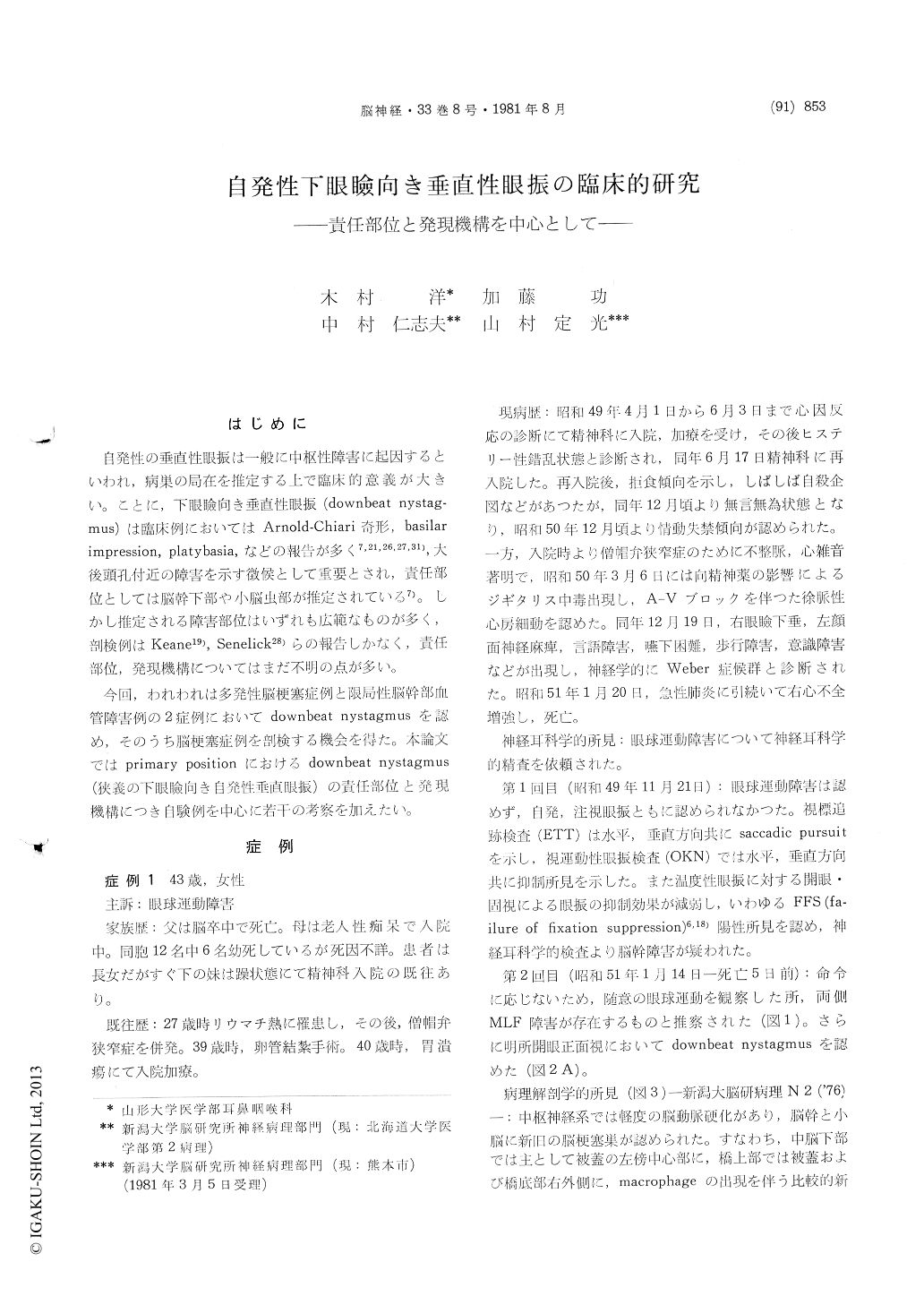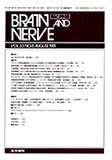Japanese
English
- 有料閲覧
- Abstract 文献概要
- 1ページ目 Look Inside
はじめに
自発性の垂直性眼振は一般に中枢性障害に起因するといわれ,病巣の局在を推定する上で臨床的意義が大きい。ことに,下眼瞼向き垂直性眼振(downbeat nystag—mus)は臨床例においてはArnold-Chiari奇形,basilar impression,platybasia,などの報告が多く7,21,26,27,31),大後頭孔付近の障害を示す徴候として重要とされ,責任部位としては脳幹下部や小脳虫部が推定されている7)。しかし推定される障害部位はいずれも広範なものが多く,剖検例はKeane19),Senelick28)らの報告しかなく,責任部位,発現機構についてはまだ不明の点が多い。
今回,われわれは多発性脳梗塞症例と限局性脳幹部血管障害例の2症例においてdownbeat nystagmusを認め,そのうち脳梗塞症例を剖検する機会を得た。本論文ではprimary positionにおけるdownbeat nystagmus(狭義の下眼瞼向き自発性垂直眼振)の責任部位と発現機構につき自験例を中心に若干の考察を加えたい。
Unusual and bizarre abnormaliteis of ocular move-ment are often valuable localizing signs of central nervous system disease. Subsequent reports have confirmed the association between downbeat nys-tagmus and abnormalities at the cranio-cervical junction, such as the Arnold-Chiari malformation, platybasia and basilar invagination. The mechanism of downbeat nystagmus, however, remains uncertain although the downbeat nystagmus have been presumptive evidence of a lesion in the lower end of the brain stem or cerebellum. Only two path-ologically studied cases of downbeat nystagmus are briefly described in the literature. The present paper is a report of two cases of spontaneous down-beat nystagmus including a pathological examina-tion. Therefore, the precise localizing value of downbeat nystagmus and mechanism for the occur-rence of spontaneous downbeat nystagmus were discussed.
Case 1-A 43-year-old woman with a history of mitral insufficiency was admitted to our hospital for the second time for psychosis. Approximately one month before her death, she had left facial palsy and alternate hemiplegia, so the diagnosis of Weber's syndrome was made.
5 days before her death, second neuro-otological examination was performed. She had bilateral internuclear ophthalmoplegia and showed downbeat nystagmus on forward gaze in room light. Smooth eye tracking and optokinetic responses were absent horizontally and vertically. She died from acute pneumonia. Pathological examination revealed multiple infarcts in the brain stem and cerebellum; (1) old and recent infarcts in the midbrain and upper pons; involving the medial longitudinal fasciculus (MLF), crossed fiber of supperior cerebel-lar peduncle, central tegmental tract, mesencephalic tract of the trigeminal nerve, locus caeruleus and a part of medial lemniscus on the left side, medial parts of the substantia nigra, front-pontine fibers and pontine base on both sides, as well as in the tegmentum of the medulla oblongata including bilateral vestibular nuclei and inferior cerebellar peduncles. (2) multiple old and recent infarcts in the cerebellum folia and the right dentate nucleus.
Case 2-A 59-year-old man was admitted to our hospital in May 1977, complaining of difficulty walk, double vision, vertigo and dysphagia. On admission, mental status was normal. The pupils were of equal size and reacted briskly.
There was inability to left lateral gaze, and downbeat nystagmus was present in complete darkness. Horizontal nystagmus to the left was also present on forward, left, up and down gaze, and right-beating nystagmus was seen on right gaze. Smooth eye tracking test revealed the deficit of smooth pursuit to the left and downward.
Results of all laboratory tests were completely normal including spinal fluid examination, arterio-graphy, and CT scanning. Neurological and neuro-otological symptoms suggested that the lesion was considered as probably being vascular in origin and lacated somewhere along the MLF, paramedian pontine reticualr formation (PPRF) and/or vestibular neucleus.
Dominant features in our cases were inter-nuclear ophthalmoplegia and the deficit of vertical smooth pursuit system. Therefore, spontaneous downbeat nystagmus resulted from a deficit of vertical eye movement control system, and also the impairment of horizontal oculomotor pathway caused this nys-tagmus. This report confirmed that vertical and/ or horizontal eye movement control system could be defective with lesions in the caudal brain stem. Our results, therefore, suggested that downbeat nystagmus had been better correlated clinically with lesions of the inferior half of the pons and the medulla.
It was the hope that an analysis of these cases would yield clinically useful information on topolo-gic, and possible etiologic, siginificance of downbeat nystagmus.

Copyright © 1981, Igaku-Shoin Ltd. All rights reserved.


